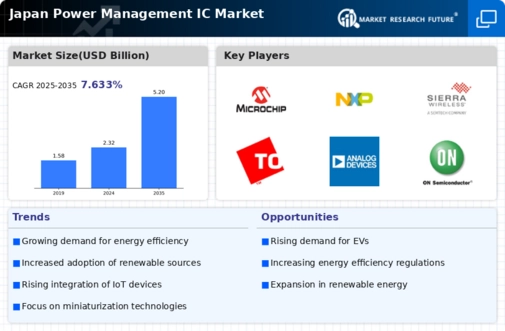Rising Demand for Consumer Electronics
The power management-ic market experiences a notable surge in demand driven by the increasing consumption of consumer electronics. With the proliferation of smartphones, tablets, and wearable devices, manufacturers are compelled to enhance energy efficiency and battery life. In 2025, the consumer electronics sector is projected to contribute approximately 30% to the overall power management-ic market revenue. This trend necessitates the development of advanced power management solutions that can optimize energy usage while maintaining performance. As consumers become more environmentally conscious, the emphasis on energy-efficient devices is likely to intensify, further propelling the market's growth. Consequently, companies are investing in innovative technologies to meet these evolving consumer expectations, thereby shaping the future landscape of the power management-ic market in Japan.
Increased Focus on Smart Home Technologies
The rising interest in smart home technologies is driving growth in the power management-ic market. As consumers seek to enhance convenience and energy efficiency in their homes, the demand for smart devices such as thermostats, lighting systems, and security cameras is on the rise. In 2025, the smart home market in Japan is projected to grow by 30%, creating a substantial opportunity for power management-ic manufacturers. These devices require sophisticated power management solutions to optimize energy consumption and ensure seamless operation. Consequently, the power management-ic market is likely to witness increased collaboration between technology providers and manufacturers to develop integrated solutions that cater to the evolving needs of consumers. This trend underscores the importance of innovation in driving the future of the power management-ic market.
Expansion of Electric Vehicle Infrastructure
The expansion of electric vehicle (EV) infrastructure in Japan significantly impacts the power management-ic market. As the country aims to achieve carbon neutrality by 2050, the demand for EVs is expected to rise sharply. In 2025, the EV market is projected to grow by 25%, necessitating advanced power management solutions to optimize battery performance and charging efficiency. This growth presents opportunities for power management-ic manufacturers to develop specialized products tailored for EV applications. Furthermore, the integration of smart charging systems and energy management solutions will likely enhance the overall efficiency of the EV ecosystem. Consequently, the power management-ic market is poised to benefit from this transition, as stakeholders seek to address the challenges associated with increased EV adoption and infrastructure development.
Government Initiatives for Energy Conservation
Government policies in Japan play a pivotal role in shaping the power management-ic market. Initiatives aimed at energy conservation and sustainability are increasingly influencing market dynamics. The Japanese government has set ambitious targets to reduce greenhouse gas emissions by 46% by 2030, which necessitates the adoption of energy-efficient technologies. This regulatory environment encourages manufacturers to innovate and integrate advanced power management-ic solutions into their products. In 2025, it is anticipated that government incentives will drive a 15% increase in the adoption of power management-ic technologies across various sectors, including industrial and residential applications. As a result, the power management-ic market is likely to benefit from enhanced collaboration between public and private sectors, fostering a conducive environment for growth.
Technological Advancements in Semiconductor Manufacturing
Technological advancements in semiconductor manufacturing are reshaping the power management-ic market in Japan. Innovations such as 5nm and 7nm process technologies enable the production of smaller, more efficient power management-ic solutions. These advancements facilitate the development of high-performance devices that consume less energy, aligning with the growing demand for energy-efficient products. In 2025, it is estimated that the adoption of advanced semiconductor technologies will contribute to a 20% reduction in power consumption across various applications. This trend not only enhances device performance but also supports sustainability efforts within the power management-ic market. As manufacturers continue to invest in research and development, the landscape of power management-ic solutions is likely to evolve, offering new opportunities for growth and innovation.
























Leave a Comment